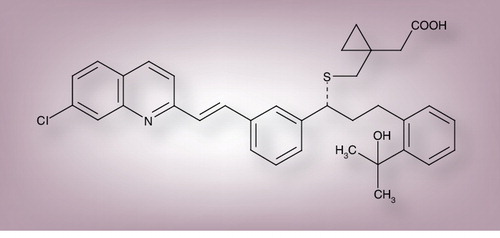Figures & data
Redrawn with permission from Citation[29].
![Figure 1. The multiple cellular effects of leukotrienes in the airways.Redrawn with permission from Citation[29].](/cms/asset/7800efb1-713f-45dd-81ea-704d188cce54/ierm_a_11212027_f0001_b.jpg)
(A) No difference could be seen between adding montelukast to budesonide 400 µg twice daily, compared with doubling the dose when all patients where included. (B) For those with concomittant rhinitis, montelukast proved to be superior.
LS: Least square; SEM: Standard error of the mean.
Redrawn with permission from Citation[87].
![Figure 3. Subanalysis of the Clinical Outcomes with Montelukast as a Partner Agent to Corticosteroid Therapy (COMPACT) trial.(A) No difference could be seen between adding montelukast to budesonide 400 µg twice daily, compared with doubling the dose when all patients where included. (B) For those with concomittant rhinitis, montelukast proved to be superior.LS: Least square; SEM: Standard error of the mean.Redrawn with permission from Citation[87].](/cms/asset/ac7582e2-949a-4fa6-a014-76c4dd2a733f/ierm_a_11212027_f0003_b.jpg)
Open circles represent samples in which the CysLT concentration was less than the detection limit. Horizontal bars represent median values.
CysLT: Cysteinyl leukotriene; EIB: Exercise-induced bronchoconstriction.
Redrawn with permission from Citation[111].
![Figure 4. CysLT levels in exhaled breath condensate in asthmatic children, 7–18 years of age, with exercise-induced bronchoconstriction, without exercise-induced bronchoconstriction and healthy control children.Open circles represent samples in which the CysLT concentration was less than the detection limit. Horizontal bars represent median values.CysLT: Cysteinyl leukotriene; EIB: Exercise-induced bronchoconstriction.Redrawn with permission from Citation[111].](/cms/asset/0276e4d4-7728-471f-a36a-ff75283e2f6f/ierm_a_11212027_f0004_b.jpg)
After a 2.5-month baseline period, children were randomized to receive daily montelukast or placebo for 2.5 months (treatment interval). Urine samples were collected twice a day, on 8 consecutive days, during the baseline and the treatment interval and LTE4 and cotinine levels were measured. Use of albuterol was monitored daily. During the baseline interval, urine LTE4 levels in all subjects were strongly associated with increased albuterol use (21.9% increase in albuterol usage per LTE4 interquartile range increase [IQR; p = 0.003]) 2 days after urine collection. Shown are mean estimates and 95% CI for change in albuterol use per IQR in LTE4, modified by (A) sex and (B) mean cotinine. Estimates are given for BL and TRT.
BL: Baseline; IQR: Interquartile range; TRT: Treatment.
Redrawn with permission from Citation[124].
![Figure 5. Effect modifiers of the montelukast effect on LTE4-associated albuterol usage by children with asthma (n = 28; age 6–15 years).After a 2.5-month baseline period, children were randomized to receive daily montelukast or placebo for 2.5 months (treatment interval). Urine samples were collected twice a day, on 8 consecutive days, during the baseline and the treatment interval and LTE4 and cotinine levels were measured. Use of albuterol was monitored daily. During the baseline interval, urine LTE4 levels in all subjects were strongly associated with increased albuterol use (21.9% increase in albuterol usage per LTE4 interquartile range increase [IQR; p = 0.003]) 2 days after urine collection. Shown are mean estimates and 95% CI for change in albuterol use per IQR in LTE4, modified by (A) sex and (B) mean cotinine. Estimates are given for BL and TRT.BL: Baseline; IQR: Interquartile range; TRT: Treatment.Redrawn with permission from Citation[124].](/cms/asset/9651c569-3d91-4fa5-b6a3-e59448e84f03/ierm_a_11212027_f0005_b.jpg)
Figure 6. (A) Differences between montelukast and placebo treatment in percentages of days with worse asthma symptoms in boys according to age group. (B) Differences between montelukast and placebo treatment in percentages of days with worse asthma symptoms in girls according to age group.
NS: Not significant.
Redrawn with permission from Citation[134].
![Figure 6. (A) Differences between montelukast and placebo treatment in percentages of days with worse asthma symptoms in boys according to age group. (B) Differences between montelukast and placebo treatment in percentages of days with worse asthma symptoms in girls according to age group.NS: Not significant.Redrawn with permission from Citation[134].](/cms/asset/3ee103df-5888-46ee-93aa-7b194c1ac666/ierm_a_11212027_f0006_b.jpg)
